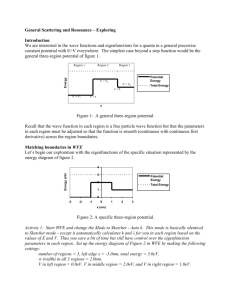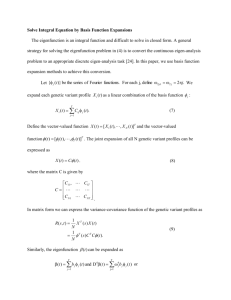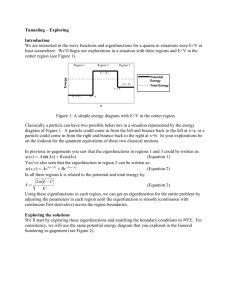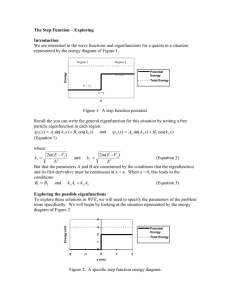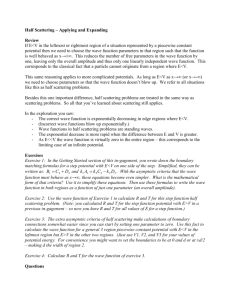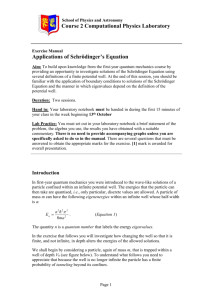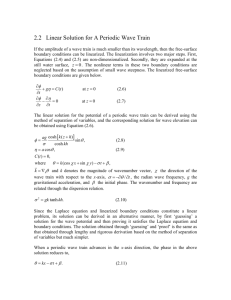Half Scattering
advertisement
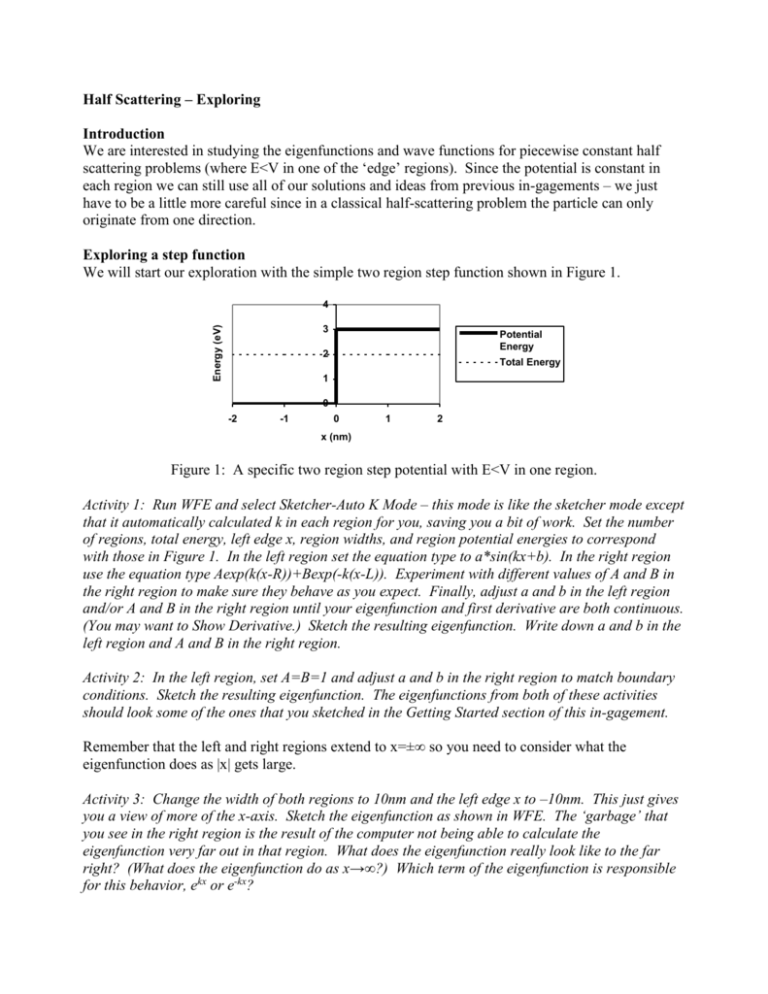
Half Scattering – Exploring Introduction We are interested in studying the eigenfunctions and wave functions for piecewise constant half scattering problems (where E<V in one of the ‘edge’ regions). Since the potential is constant in each region we can still use all of our solutions and ideas from previous in-gagements – we just have to be a little more careful since in a classical half-scattering problem the particle can only originate from one direction. Exploring a step function We will start our exploration with the simple two region step function shown in Figure 1. Energy (eV) 4 3 Potential Energy 2 Total Energy 1 0 -2 -1 0 1 2 x (nm) Figure 1: A specific two region step potential with E<V in one region. Activity 1: Run WFE and select Sketcher-Auto K Mode – this mode is like the sketcher mode except that it automatically calculated k in each region for you, saving you a bit of work. Set the number of regions, total energy, left edge x, region widths, and region potential energies to correspond with those in Figure 1. In the left region set the equation type to a*sin(kx+b). In the right region use the equation type Aexp(k(x-R))+Bexp(-k(x-L)). Experiment with different values of A and B in the right region to make sure they behave as you expect. Finally, adjust a and b in the left region and/or A and B in the right region until your eigenfunction and first derivative are both continuous. (You may want to Show Derivative.) Sketch the resulting eigenfunction. Write down a and b in the left region and A and B in the right region. Activity 2: In the left region, set A=B=1 and adjust a and b in the right region to match boundary conditions. Sketch the resulting eigenfunction. The eigenfunctions from both of these activities should look some of the ones that you sketched in the Getting Started section of this in-gagement. Remember that the left and right regions extend to x=±∞ so you need to consider what the eigenfunction does as |x| gets large. Activity 3: Change the width of both regions to 10nm and the left edge x to –10nm. This just gives you a view of more of the x-axis. Sketch the eigenfunction as shown in WFE. The ‘garbage’ that you see in the right region is the result of the computer not being able to calculate the eigenfunction very far out in that region. What does the eigenfunction really look like to the far right? (What does the eigenfunction do as x→∞?) Which term of the eigenfunction is responsible for this behavior, ekx or e-kx? Asymptotic behavior and constraints on solutions These eigenfunctions have a problem. When E<V in the rightmost (or leftmost) region, we have to use an eigenfunction of the form ( x) Ce kx De kx in that region. But the term ekx ‘blows up’ as x→∞ (and the term e-kx ‘blows up’ as x→-∞). If the eigenfunction blows up so does the probability density and an infinite probability density makes no sense at all! The easiest way to overcome this difficulty is to reject the offending term as a physical solution in the edge regions. Thus if E<V in the rightmost (leftmost) region we simply set C=0 (D=0) in that region. Of course this will remove one of the two free parameters leaving only one - the overall amplitude of the wave function. Instead of two linearly independent wave functions and all of their superpositions (which we had in the general scattering case) we only have one wave function for each energy level. But this fits nicely with the classical notion that there is really only one type of motion for this energy diagram - a particle coming in from the left and bouncing off the potential back toward the left. Activity 3: To get a physically correct eigenfunction in WFE, set A=0 (recall that C Ae kR ) in the right region and readjust B, a, and b until the function and first derivative are both continuous. (Also set the left edge x back to –2.0nm and the region widths back to 2.0nm). Sketch the result. This is the only correct eigenfunction for this energy diagram! Studying the wave functions Now let's look at the time behavior of the wave functions. Activity 4: Switch to Explorer mode in WFE. All of your previous settings should be copied over. Notice that you cannot choose the connect direction or change any eigenfunction parameters. This is because there is just one possible wave function for each value of total energy. Press the run button and watch the wave function and probability density. Press the stop button and sketch them. Press the run button again and describe their behavior in time. Activity 5: Change the total energy to about 0.2eV and sketch the probability density. How is this different from the one in Activity 4? Make sure you look in both regions. Activity 6: Change the total energy to about 2.9eV and sketch the probability density. Can you see the effects of different total energies on the wavelength and decay length? Describe them. Activity 7: Predict what you would expect to see for an energy of exactly 3.0eV. Then try it out and compare the results to your prediction. Behavior for very high steps Activity 8: Change the total energy to about 1.0eV and then increase the potential energy in the right region upwards towards about 80eV. What happens to the shape of the wave function and probability density in the right region as the potential step gets larger? How is this probability density more like what you would expect to see for a classical particle in the same energy diagram? What value is the wave function approaching at the boundary as the potential on the right increases? (Note: as the potential gets above 80eV or so you will begin to see some changes near the right side of the right region - these are just numeric artifacts of finite precision arithmetic they are not real predictions of quantum mechanics.) Frequently quantum mechanics textbooks use the example of a region with an infinite potential energy. Due to the effects that you saw in Activity 8 they require that the value of the wave function is exactly zero in such a region. This makes calculating boundary conditions very easy since matching a sine type function to zero is easy - you just make sure a multiple of pi lands on the boundary and the sine function will automatically be zero there also. However, this simplification (which of course can't happen physically at all) introduces an additional problem - you can never match the derivative of the wave function at the boundary. (There are mathematical tricks to get around this problem but we won't discuss those here.) Physically you can achieve a very large potential change which makes the wave function almost zero at the boundary and makes it decay so fast that the derivative changes extremely rapidly almost looking discontinuous. If you are trying to do rapid "back of the envelope" calculations the "infinite" potential wall can be an extremely useful tool. However, when using it you should always be aware that it is an approximation and, as such, has limited applicability. Of course even the finite step potentials that we are studying are an approximation - no real physical situation has a discontinuity in the potential energy function... Other half scattering problems You will get a similar half scattering problem for any potential where E<V in either the leftmost or rightmost region. Let's look at one more specific half scattering problem (which also happens to have resonances). Activity 9: Open WFE and put it into Explorer mode. Set the number of regions to 4. This will automatically set the region widths to 1.5nm. Set the region potentials to 7.0eV, 2.0eV, 4.0eV, and 0.0eV (from left to right). This potential is a half scattering problem for any total energy between 0.0eV and 7.0eV. (For higher energies it is a regular scattering problem - for lower energies it has no solutions.) Set the total energy to 8.0eV. Notice that since this is a regular scattering problem you can set the eigenfunction parameters and connect direction. Lower the energy to just below 7.0eV. Notice that since this is now a half scattering problem and has only one solution WFE no longer lets you adjust those connection parameters. Look at the wave function and probability density for several different total energies between 0.0eV and 7.0eV - choose a couple to sketch. Activity 10: Since this potential also has a local minimum we can expect that it might have resonance energies between 2.0eV and 4.0eV. Find as many as you can and sketch their probability densities (and write down their resonance energy values). Note: these can be hard to find but they are there – make use of your predictions about their wavelengths from the previous ingagement. Conclusion Now you are equipped to find stationary state solutions to any scattering or half scattering problem in any piecewise constant potential. The method is always the same: divide up the potential into regions where it is constant, write down the wave function in each region, write down and solve the boundary condition equations, and finally apply what ever additional conditions you need to get the solution you want (for scattering you apply conditions to get the two traveling wave solutions - for half scattering you apply a condition to keep the wave function finite at x=±∞.
